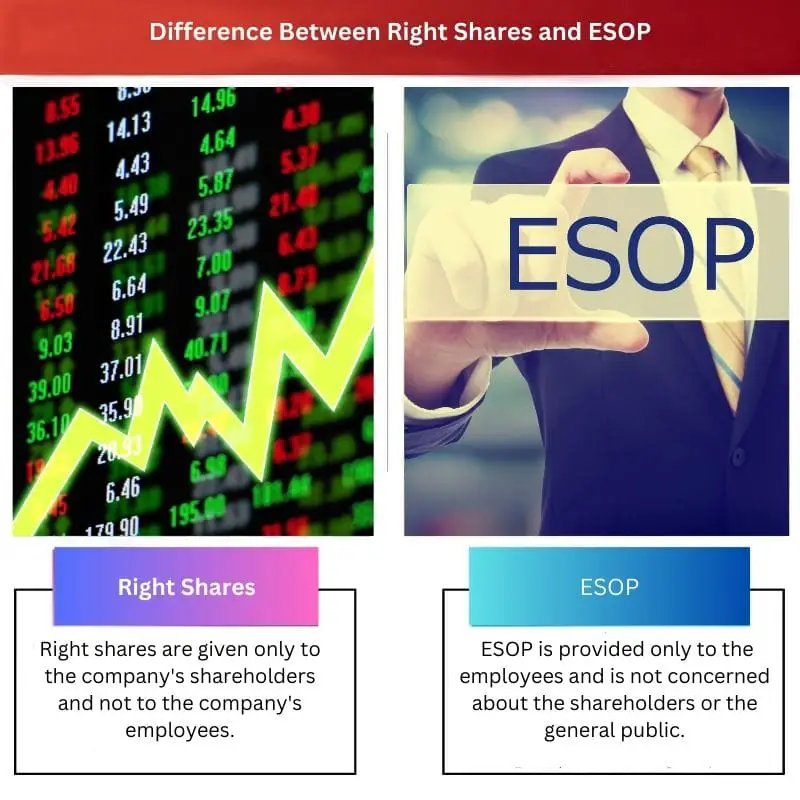Rights Shares and Employee Stock Ownership Plans (ESOPs) are different equity instruments used by companies. Rights Shares are offered to existing shareholders at a discounted price to raise capital, while ESOPs are a mechanism for employees to acquire company shares, often as part of their compensation.
Key Takeaways
- Right shares are a type of stock offering where existing shareholders can purchase additional shares in proportion to their current holdings, at a discounted price.
- ESOP (Employee Stock Ownership Plan) is a benefit program that grants employees ownership, by allocating company shares or stock options.
- Right shares focus on providing existing shareholders an opportunity to invest further, while ESOPs are designed to benefit and incentivize employees through company ownership.
Right Shares vs ESOP
The difference between Right shares and ESOP is that they target two different stakeholders. Right shares tend to target the already existing shareholders of the company, whereas ESOP targets the employees.

Right shares of a company’s existing shareholders sanction them to buy additional shares directly from the company in proportion to their existing shareholding but at a discount to the current market trading price.
Comparison Table
| Feature | Right Shares | ESOP (Employee Stock Option Plan) |
|---|---|---|
| Type of Instrument | Shares | Option to purchase shares |
| Granting | Offered to existing shareholders on a pre-emptive basis (proportional to existing holdings) | Offered to employees by the company |
| Cost | Typically issued at a discount to the current market price | May be issued at a discount, at fair market value, or at a premium |
| Ownership & Rights | Shares become part of the shareholder’s ownership with full voting rights and dividend entitlement upon payment. | Employee doesn’t own shares until they exercise the option (purchase). No voting rights until shares are owned. May or may not receive dividends depending on the plan. |
| Exercise | No action required. Shares are automatically credited upon payment. | Employee has the right, but not the obligation, to purchase the shares at the exercise price within a specific timeframe. |
| Taxation | Taxed as income upon receipt (dividend distribution may also be taxed) | Taxed upon exercise (difference between exercise price and market price). |
| Upside Potential | Shareholder benefits from any increase in share price. | Employee benefits if the share price increases above the exercise price. |
| Downside Risk | Shareholder bears the risk if the share price falls. | Employee loses nothing if they don’t exercise the option and the share price falls. May lose money if the exercise price is higher than the market price when they exercise. |
| Suitability | For existing investors who want to increase their ownership stake at a discounted price. | For companies to incentivize and retain employees by giving them a stake in the company’s success. |
What are Right Shares?
Purpose of Right Shares
Right shares serve several purposes:
- Capital Infusion: The primary objective of right shares is to infuse additional capital into the company. This capital can be used for various purposes such as funding expansion projects, reducing debt, or meeting working capital requirements.
- Existing Shareholder Participation: Right shares give existing shareholders the opportunity to maintain or increase their ownership stake in the company. This helps in maintaining the ownership structure and prevents dilution.
- Fairness: Offering right shares to existing shareholders is considered a fair way to raise capital, as it provides them the first opportunity to subscribe to the new shares before they are offered to external investors.
Mechanics of Right Shares
- Issue of Rights: The company issues rights to existing shareholders in proportion to their current shareholding. For example, if a shareholder holds 100 shares, they may be entitled to purchase 10 additional shares through the right issue.
- Subscription Period: Shareholders are given a specific period, known as the subscription period, during which they can exercise their right to purchase the additional shares. This period is determined by the company and is usually a few weeks.
- Subscription Price: The company sets a predetermined price at which the right shares can be purchased. This price is often lower than the current market price, making it an attractive proposition for existing shareholders.
- Tradability: Rights issued to shareholders can be traded on the stock exchange, allowing shareholders who do not wish to subscribe to sell their rights to others who may be interested in purchasing additional shares.
Advantages of Right Shares
- Equitable Capital Raising: Right issues offer a fair chance to existing shareholders to participate in the company’s growth without diluting their ownership significantly.
- Cost-Effective: Compared to other methods of raising capital, such as public offerings, right issues are often more cost-effective for the company.
- Flexibility: Companies have the flexibility to tailor the right issue to their specific capital needs and the preferences of their existing shareholders.
Risks and Considerations
- Dilution: While right issues aim to minimize dilution for existing shareholders, it still results in some level of dilution, especially if not all shareholders choose to exercise their rights.
- Market Conditions: The success of a right issue is influenced by market conditions. If the market perceives the subscription price as too high, shareholders may not fully subscribe to their rights.
- Shareholder Participation: The effectiveness of a right issue depends on the level of participation by existing shareholders. If a significant portion of shareholders chooses not to exercise their rights, the capital-raising objectives may not be fully achieved.

What is ESOP?
How ESOPs Work
1. Establishment and Structure
An ESOP is established by a company as a trust, which then holds shares on behalf of employees. This trust is managed by a trustee, often appointed by the company.
2. Employee Participation
Employees become participants in the ESOP, and their allocation of shares is determined by factors such as salary, years of service, or a combination of both. Over time, employees accumulate shares in their individual ESOP accounts.
3. Vesting Period
ESOPs typically have a vesting period, during which employees earn the right to the allocated shares. Once vested, employees can access their shares upon retirement or other qualifying events.
Benefits of ESOPs
1. Employee Motivation and Retention
ESOPs create a sense of ownership and responsibility among employees, fostering a stronger commitment to the company’s success. This can contribute to increased motivation and higher employee retention rates.
2. Retirement Savings
ESOPs provide a valuable retirement savings vehicle for employees, allowing them to accumulate wealth through the appreciation of company stock over time.
3. Tax Advantages for Companies
Companies that implement ESOPs may benefit from certain tax advantages. Contributions to the ESOP can be tax-deductible, helping companies manage their tax liabilities.
Risks and Considerations
1. Stock Volatility
The value of ESOP shares is directly tied to the performance of the company’s stock. As a result, employees may experience fluctuations in the value of their ESOP accounts based on market conditions.
2. Lack of Diversification
Employees heavily invested in ESOPs may lack diversification in their retirement portfolios, as their financial well-being is closely tied to the success of a single company.
3. Liquidity Concerns
Accessing the value of ESOP shares can be challenging before retirement, potentially limiting employees’ ability to use these assets for other financial needs.

Main Differences Between Right Shares and ESOP
- Purpose:
- Right Shares:
- Issued to existing shareholders in proportion to their current holdings.
- Mainly used to raise additional capital from existing investors.
- ESOP (Employee Stock Ownership Plan):
- Issued to employees as a part of their compensation package.
- Aimed at aligning employees’ interests with the company’s performance.
- Right Shares:
- Recipients:
- Right Shares:
- Offered to existing shareholders.
- ESOP:
- Offered to employees, providing them with an opportunity to own a stake in the company.
- Right Shares:
- Price:
- Right Shares:
- Typically offered at a discounted price to the current market value.
- ESOP:
- The price may be at the market rate or a discounted rate, but it is often structured to be affordable for employees.
- Right Shares:
- Usage:
- Right Shares:
- Used to raise funds for various purposes such as expansion, debt reduction, or working capital.
- ESOP:
- Implemented as a part of employee benefit plans to attract, retain, and motivate employees.
- Right Shares:
- Control and Ownership:
- Right Shares:
- Existing shareholders maintain their proportional ownership.
- ESOP:
- Employees may gain ownership, but control usually remains with existing management and shareholders.
- Right Shares:
- Timing:
- Right Shares:
- Issued when the company needs additional capital.
- ESOP:
- Part of the company’s long-term strategy, often with a vesting period for employees.
- Right Shares:
- Impact on Dilution:
- Right Shares:
- May lead to dilution for existing shareholders as new shares are issued.
- ESOP:
- Dilution occurs as employees exercise their options, leading to an increase in the total number of shares outstanding.
- Right Shares:
- Regulatory Requirements:
- Right Shares:
- Subject to regulatory approvals but may have fewer compliance requirements compared to ESOP.
- ESOP:
- Typically subject to more stringent regulatory and disclosure requirements due to the involvement of employee benefits.
- Right Shares:
- Market Perception:
- Right Shares:
- Generally perceived as a way for the company to raise capital.
- ESOP:
- Seen as a tool to attract and retain talent, fostering a sense of ownership among employees.
- Right Shares:

- https://www.bvreview.org/doi/pdf/10.5791/0882-2875-18.3.100
- https://search.proquest.com/openview/96870bf38020de8f9cc5a486e7e40fc7/1?pq-origsite=gscholar&cbl=41798

The comparison table effectively outlines the key differences between right shares and ESOP, making it a valuable resource for stock market enthusiasts.
I couldn’t agree more, Hughes Ruby. The post serves as an excellent reference for understanding these stock market concepts.
The post does well in highlighting the key differences between right shares and ESOP. It’s quite beneficial for those seeking to enhance their knowledge of stock markets.
I concur, Patricia Cooper. The content provides a valuable breakdown of these concepts.
The article’s detailed explanation of right shares and ESOP is a commendable effort, offering valuable insights for those engaged in stock markets.
Absolutely, Murphy Summer. The post provides an in-depth understanding of these crucial concepts in stock market operations.
The post elucidates the intricacies of right shares and ESOP in a thought-provoking manner. It’s an excellent read for those interested in the stock market.
Absolutely, Noah Smith. The details provided in the post offer a well-rounded understanding of these vital topics.
The post’s distinction between right shares and ESOP is quite insightful, which can benefit investors or individuals involved in company shares and stocks.
Indeed, Mtaylor. The clarity in explaining the differences between right shares and ESOP is commendable.
The article’s analytical approach to delineating the differences between right shares and ESOP is a beneficial resource for individuals delving into stock investments.
Indeed, Poppy Lewis. The in-depth analysis in the post is advantageous for anyone seeking to expand their knowledge of the stock market.
While the article is informative, the tone can be quite technical and may not be easily digestible for the average reader.
I agree, Hall Candice. The technical nature of the post might deter some readers from fully engaging with the content.
I understand your point, Hall Candice. It would be helpful to incorporate more relatable examples for better clarity.
The article seems to provide a clear and comprehensive explanation of right shares and ESOP. It’s definitely valuable for those looking to invest or understand more about the stock market.
I completely agree, Luke57. I appreciate the detailed comparison provided in the post.
This article is a fantastic resource for anyone trying to gain a better understanding of the stock market and investment opportunities.
An excellent explanation for anyone looking to understand the difference between right shares and ESOP. The comparison table was especially helpful in highlighting their distinctions.
I agree, Kimberly. The post is very informative and accessible to all readers.
Yes, I found the explanation quite helpful and easy to grasp. Great job!
While the content is informative, it would be beneficial to incorporate real-world examples to further illustrate the applications of right shares and ESOP.
I agree with your point, Patel Adrian. Real-world scenarios can enhance the post’s relatability to the readers.